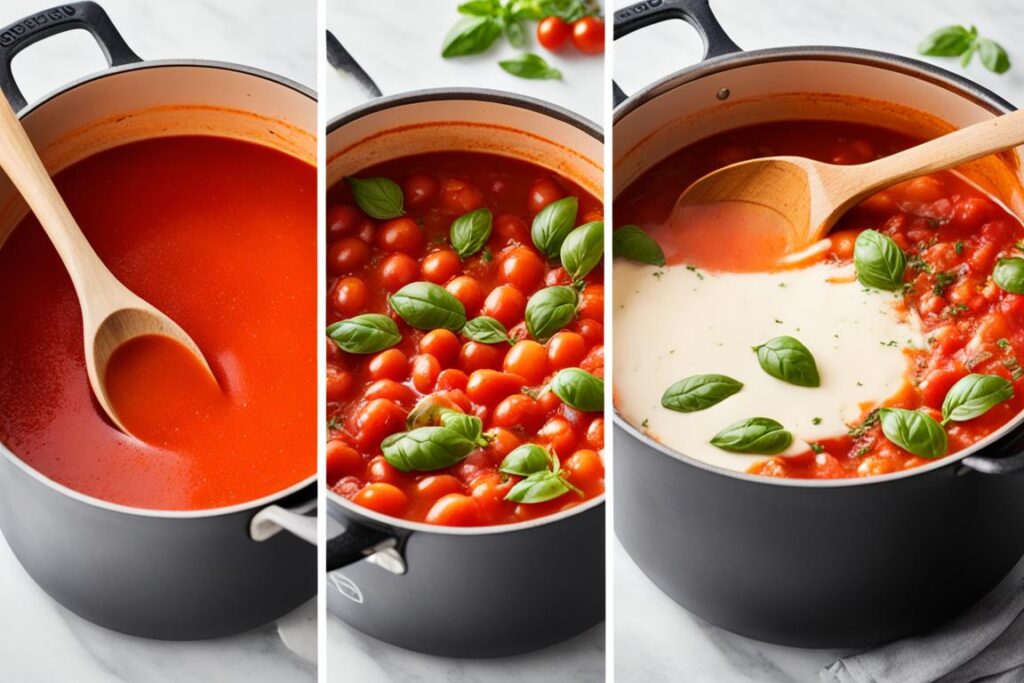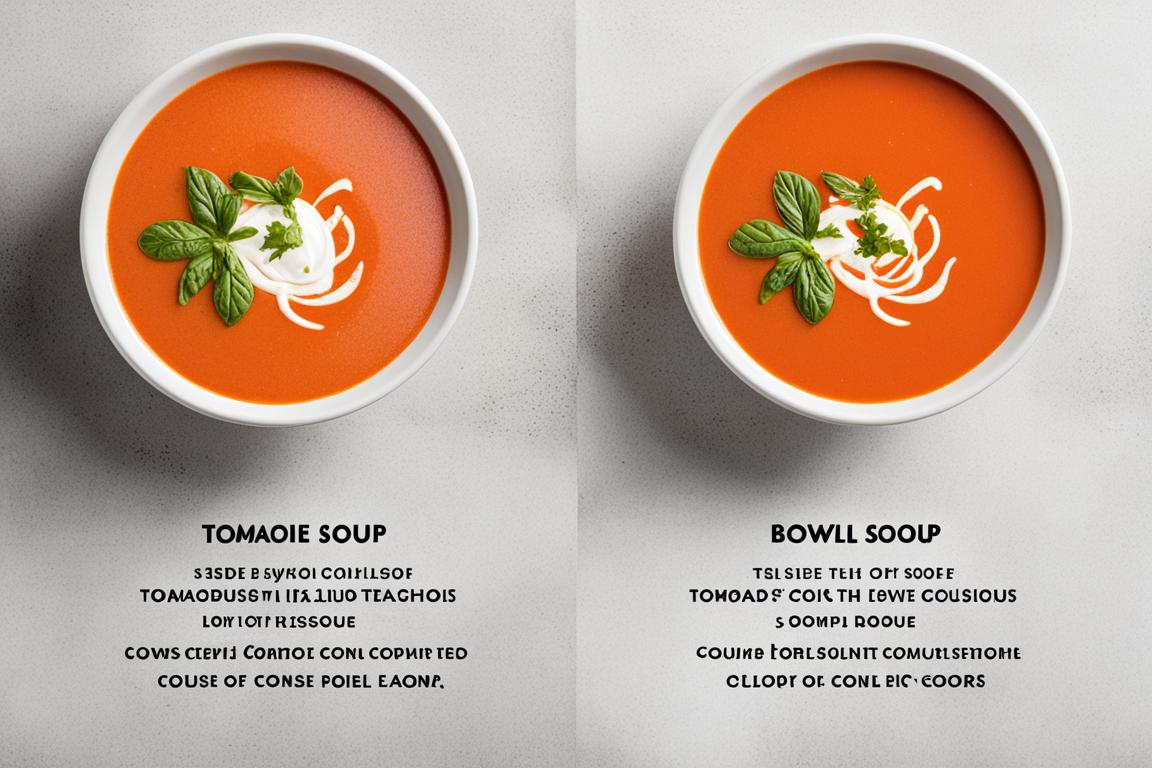Ever wondered why tomato soup and bisque are often mixed up? They may look similar, but they’re actually quite different. Let’s explore what makes tomato soup and bisque unique. We’ll look at their origins, ingredients, cooking methods, and flavors.
This article is for food lovers and casual diners who want to know more about these soups. We’ll show you how they differ and what makes each special.
Key Takeaways
- Tomato soup is typically smooth and milder in flavor compared to bisque.
- Bisque is richer, often containing cream and seafood elements.
- Both soups have distinct origins and cultural significance.
- The preparation and cooking methods vary significantly between the two.
- Garnishes can elevate both soups, enhancing their visual appeal and taste.
Understanding Tomato Soup
Tomato soup is a favorite broth-based soup that brings comfort to many. It’s made with tomatoes, broth, and seasonings. This makes it simple yet versatile. Many love its gentle taste, especially in cold weather for its warmth and satisfaction.
Canned tomato soup is easy to find and often includes tomato puree, tomato paste, water, and preservatives. These canned options are quick to prepare and offer a tasty bowl of comfort food. Paired with grilled cheese sandwiches, it becomes a classic combo that makes meals special.
Whether homemade or from a can, this broth-based soup is a key dish in American kitchens. For those wanting to try something new, tomato bisque is a great choice. It has a creamier texture and richer flavor. Sharing this dish with others makes it a beloved favorite.
| Feature | Tomato Soup | Tomato Bisque |
|---|---|---|
| Texture | Thin and light | Thick and creamy |
| Main Ingredients | Tomatoes, broth | Tomatoes, broth, cream |
| Cooking Time | Quick preparation | Longer preparation due to cream |
| Servings | Usually served as a main dish | Often served as a starter |
Tomato soup and bisque each offer unique experiences for those seeking comfort. They both hold a special place in the hearts of food lovers. This makes them top choices in the comfort food category.
For more ideas and variations, check out this beloved soup’s delicious options.
Explore creative recipes here.
Origins and History of Tomato Soup
The tomato soup history goes back to the 19th century in America. It shows how cooking changed over time. At first, tomatoes were rare in American kitchens. But as they became more popular, soup became a way to use up extra food.
The early 20th century was a big change for tomato soup. The Campbell Soup Company made canned versions. This made making soup easy for families everywhere. The soup’s creamy taste brought comfort, fitting with American values of simplicity and making do with what you have.
Now, tomato soup reminds us of its simple start. It combines old cooking traditions with today’s easy ways of eating. For those curious about this classic dish, there’s more to learn at the differences between tomato soup, cream of tomato soup, and tomato.
Looking into tomato soup’s history makes us think about how cooking has changed. It shows how recipes have evolved with our lives and food technology. This story is not just about a recipe. It’s a big part of American culture that people still enjoy at home.
Key Ingredients in Tomato Soup
Tomato soup is a warm and comforting dish. It has a rich, vibrant color and a hearty flavor. The main tomato soup ingredients blend together to create its unique taste. Fresh tomatoes are key, offering a sweet and deep flavor.
A flavorful broth, whether vegetable or chicken, is crucial for the soup’s taste. Onions add an aromatic touch. Seasonings like salt, pepper, and sometimes garlic enhance the soup’s character. Fresh herbs like basil or oregano add a delightful sweetness to the tomatoes.
For a thicker soup, recipes might use flour or cornstarch. Adding cream or sour cream makes the soup even more luxurious. These key components work together to make a delicious soup.
The quality of tomatoes greatly affects the soup. Using fresh, high-quality tomatoes is essential for a great tomato soup. Knowing the tomato soup ingredients helps create a comforting dish perfect for any occasion. For a fun cooking adventure, explore the differences between tortellini and tortelloni in this article.
| Ingredient | Purpose |
|---|---|
| Fresh Tomatoes | Main flavor component |
| Broth (Vegetable/Chicken) | Flavor base enhancement |
| Onions | Aromatic foundation |
| Garlic | Additional flavor depth |
| Herbs (Basil/Oregano) | Flavor accentuation |
| Flour/Cornstarch | Consistency thickener |
| Cream/Sour Cream | Richness and creaminess |
Examining Bisque
Bisque is a creamy soup with deep roots in the French culinary tradition. It started with seafood dishes, like lobster or crab. Over time, ‘bisque’ grew to mean all kinds of creamy soups, including the popular tomato bisque.
What makes bisque special is its rich creaminess. This cream gives it a smooth and luxurious feel. Making the perfect bisque takes skill and careful cooking.
To make bisque, you start with sautéed veggies and seafood shells. These are simmered to bring out the best flavors. Then, they are blended and mixed with cream. This creates a soup that’s both complex and elegant, loved in upscale restaurants.
What’s the difference between tomato soup and bisque?
Tomato soup and bisque are different in texture and ingredients. They offer unique tastes for various occasions. Yet, they share some common elements.
Texture and Consistency
Tomato soup is light and brothier, perfect for a quick meal. Bisque, however, is rich and creamy, giving a luxurious feel. This difference comes from the heavy cream in bisque, making it smoother and richer than tomato soup.
Ingredients Comparison
The ingredients comparison shows big differences. Tomato soup has tomatoes, broth, and herbs. Bisque includes shellfish or other proteins and a roux for thickness. These ingredients give them distinct flavors and cooking experiences.
| Feature | Tomato Soup | Bisque |
|---|---|---|
| Texture | Light and Brothy | Rich and Creamy |
| Main Ingredients | Tomatoes, Broth, Herbs | Shellfish, Heavy Cream, Roux |
| Cooking Method | Simmering | Sautéing, Thickening |
Cooking Methods for Tomato Soup and Bisque
Exploring cooking methods for tomato soup and bisque shows us the key techniques needed for each dish. Making tomato soup is quick and easy, perfect for a comforting meal. Bisque, however, requires more work to get its creamy texture.
Preparation of Tomato Soup
Tomato soup starts with sautéing onions and garlic to create a base full of flavor. Then, chopped tomatoes and broth are added, along with spices like basil or oregano. The soup simmers until the tomatoes are soft, making it rich and delicious.
This simple process is found in many soup recipes. You can customize it with herbs or extra veggies.
Bisque preparation is different. It begins with a roux, which is a mix of flour and fat. Then, tomatoes, stock, and cream are added, and everything cooks until smooth. This method needs careful timing to get the flavors right, making it distinct from tomato soup.

| Aspect | Tomato Soup Preparation | Bisque Preparation |
|---|---|---|
| Base | Sautéed onions and garlic | Roux (flour and fat mixture) |
| Main Ingredient | Fresh or canned tomatoes | Tomatoes and cream |
| Cooking Time | Typically 30 minutes | About 1 hour for depth of flavor |
| Texture | Chunky and comforting | Smooth and creamy |
| Serving | Can be garnished with herbs | Often garnished with seafood or herbs |
Flavor Profiles of Tomato Soup and Bisque
Tomato soup and bisque have different flavors that suit many tastes. Tomato soup is bright and tangy, thanks to fresh tomatoes’ acidity. Adding herbs like basil or spices like cayenne can make it even better.
Bisque, on the other hand, has a richer taste. Cream adds a smooth texture and deepens the flavors. Sometimes, cheese is added, making the taste even more complex. This balance makes bisque a treat for those who love a luxurious meal.
Tomato soup and bisque are both versatile. Tomato soup is great as a light meal or starter. Bisque, however, is more gourmet. Chefs love to mix things up with both dishes, creating new tastes that people enjoy.
Adding things like croutons to tomato soup or fresh herbs to bisque can make their flavors even better. For those into Italian food, trying dishes like tortellini can show the wide range of flavors out there. For more on these flavors, check out this link.
| Flavor Profiles | Tomato Soup | Bisque |
|---|---|---|
| Primary Flavor Notes | Bright and Tangy | Rich and Rounded |
| Texture | Light and Smooth | Velvety and Creamy |
| Common Additions | Herbs, spices | Cream, cheeses |
| Meal Type | Light meal, appetizer | Gourmet comfort food |
Common Garnishes for Tomato Soup and Bisque
Garnishes make tomato soup and bisque look and taste better. For tomato soup, you can use fresh herbs, croutons, and shredded cheese. These soup garnishes add texture and match the rich flavor of tomatoes.
Bisque garnishes are a bit fancier. They might include fresh herbs, cream, or paprika. These add a special touch, making the bisque more exciting. Garnishing can really make a meal more enjoyable.
Here’s a table summarizing some common garnishes for both dishes:
| Dish | Common Garnishes | Benefits |
|---|---|---|
| Tomato Soup |
|
Enhances flavor and texture |
| Tomato Bisque |
|
Elevates presentation and taste |
If you want to try a great bisque recipe, check out this Tomato Bisque recipe. It shows how garnishes can turn a simple dish into something special.
The Role of Cream in Bisque
Cream is key to making bisque rich and luxurious. It makes the dish stand out from other soups. Bisque’s flexibility lets you try different ingredients, but the creamy texture is always there.
It comes from French cuisine and uses heavy cream for a special treat. Adding cream at the end makes sure it mixes well without messing up the dish.
Cooking techniques are important for this. They help the cream add flavor without hiding the main ingredient’s taste. This way, the cream makes the dish better without taking over.

| Factor | Description |
|---|---|
| Timing | Cream is added towards the end of cooking to prevent curdling. |
| Temperature | Lower temperatures preserve the cream’s silky consistency and prevent separation. |
| Flavor balance | The cream complements, rather than overpowers, the main ingredient, enhancing overall taste. |
Getting good at this shows you know a lot about cooking. The creamy texture is what makes bisque so appealing. For more on the differences between soup and bisque, check out this detailed source.
Conclusion
The exploration of soup differences, like tomato soup and bisque, shows a deep history of taste and texture. Tomato soup is a favorite in many American homes, enjoyed during weeknights. Bisque, on the other hand, is perfect for special events with its luxurious and creamy taste.
This comparison between tomato soup and bisque shows their unique ingredients and how they are made. It also points out how each soup fits different dining situations. This knowledge helps food lovers enjoy both soups more, whether they want something cozy or fancy.
Choosing between tomato soup and bisque depends on what you feel like eating and the event. By trying both, you can enjoy their special qualities. This way, you get to enjoy the best of both worlds.


